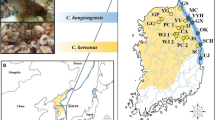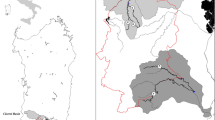Abstract
We evaluated the morphological, distributional, and genetic characteristics of the freshwater sculpin, Cottus pollux, in Kyushu Island, Japan. Based on pectoral fin ray number, the sculpins inhabiting 30 rivers were divided into two types [modes 13 (M13) and 15 (M15)]. We evaluated four environmental parameters: length of main river (L-MR), average gradient of main river (G-MR), distance from sampling site to river mouth (D-SM), and gradient around sampling site (G-S), and compared the two types. L-MR, D-SM, and G-S were significantly larger for the rivers that contained M13 fish than for those containing M15 fish. M13 individuals were distributed in the upstream areas of large river systems, suggesting a fluvial life history, whereas M15 individuals were distributed in the downstream areas of small river systems, indicating an amphidromous life history. We conducted phylogenetic analysis based on mitochondrial 12S rRNA [788 base pair (bp)] and control regions (386 bp). Mitochondrial DNA analysis showed that both M13 and M15 groups were genetically of C. pollux middle-egg type (ME). Our findings proposed the hypothesis that C. pollux ME in Kyushu Island exhibits dimorphism in both morphological and distributional traits. Additionally, haplotype distribution indicated that the fluvial M13 populations had higher genetic specificity in each river in contrast to the existence of one genetic group of amphidromous M15 individuals in Kyushu Island.


Similar content being viewed by others
References
Arnold J (1993) Cytonuclear disequilibria in hybrid zones. Annu Rev Ecol Syst 24:521‒554
Asmussen M A, Arnold J (1991) The effects of admixture and population subdivision on cytonuclear disequilibria. Theor Popul Biol 39:273‒300
Avise JC (2012) Molecular markers, natural history and evolution. Springer Science & Business Media, Berlin
Fishery Research Laboratory, Kyushu University (2014) The freshwater fish database in Kyushu and potential fauna in major plains and basins in northern Kyushu Island. http://www.agr.kyushu-u.ac.jp/lab/jikkensho/access.html. Accessed 10 May 2013
Froese R, Pauly D (2018) FishBase, ver (February 2018). World Wide Web electronic publication. http://www.fishbase.org. Accessed 10 April 2018
Fujii R (2001) Taxonomic re-examination of the freshwater sculpins in the Japanese freshwaters. Doctoral dissertation, Hokkaido University, Hakodate
Fujii S (2009) Kajika (Kasago-moku, Kajika-ka) no bunpu no seigen tonaru shin-seisokukasen [A new habitat river; the west limit of distribution of Cottus pollux (Scorpaeniformes Cottidae)]. Saga Nat Study 15:33‒37
Fujii S, Furukawa M, Matsuo T (2011) Kajika (Kasago-moku, Kajika-ka) no Kasesgawa suikei ni okeru seisoku no genjyou (Current distribution of Cottus pollux in Kase river system). Saga Nat Study 16:49‒53
Fukuoka Prefecture (2014) Red data book Fukuoka 2014. http://www.fihes.pref.fukuoka.jp/kankyo/rdb/. Accessed 1 March 2017
Fukuoka Prefecture (2016) Statistic yearbook. http://www.pref.fukuoka.lg.jp/f13/keikaku-dl.html. Accessed 23 February 2017
Geospatial Information Authority of Japan (2016) Fundamental Geospatial Data (Digiral elevation model) 10m grid. https://fgd.gsi.go.jp/download/menu.php. Accessed 23 February 2017
Goto A (1990) Alternative life-history styles of Japanese freshwater sculpins revisited. Environ Biol Fishes 28:101–112
Goto A (1998) Freshwater sculpins in Japan. In: Nakabo T, Mochizuki K (eds) Encyclopedia of Japanese Animals, vol 6. Fishes. Heibon-sha, Tokyo, pp 92–93
Goto A (2001) Cottidae. In: Kawanabe H, Mizuno N, Hosoya K (eds) Freshwater fishes of Japan. Yamatokeikoku-sha, Tokyo, pp 654–668
Goto A, Yokoyama R, Yamada M (2002) A fluvial population of Cottus pollux (middle-egg type) from the Honmyo River, Kyushu Island, Japan. Ichthyol Res 49:318‒323
Itoi S (2008) Tama-gawa de kaihuku shita kajika kotaigun no keitou bunrui ni kansuru kenkyu (Phylogenetic classification research on the restored population of Cottus pollux in Tama river). The Tokyu Foundation for Better Environment, Tokyo 37:1‒23
Kurawaka K (1976) Study of speciation in fish. Doctoral dissertation, Kyoto University, Kyoto
Kumamoto Prefecture (2014) Red list Kumamoto 2014. http://www.pref.kumamoto.jp/kiji_6105.html. Accessed 1 March 2017
Kumamoto Prefecture (2016) Statistic yearbook. https://www.pref.kumamoto.jp/kiji_1996.html. Accessed 23 February 2017
Lee DS, Gilbert CR, Hocutt, CH, Jenkins RE, McAllister DE, Stauffer Jr JR (1980) Atlas of North American Freshwater Fishes. North Carolina State Museum of Natural History
Ministry of Land, Infrastructure, Transport and Tourism (2016) Statistic data, river of Japan. https://www.mlit.go.jp/river/toukei_chousa/index.html#kasen. Accessed 23 February 2017
Ministry of the Environment Government of Japan (2017) Red list 2017, Ministry of the Environment. http://www.env.go.jp/index.html. Accessed 3 April 2018
Mukai T, Naruse K, Sato T, Shima A, Morosawa M (1997) Multiregional introgressions inferred from the mitochondrial DNA phylogeny of a hybridizing species complex of gobiid fishes, genus Tridentiger. Mol Biol Evol 14:1258‒1265
Nagasaki Prefecture (2011) Red data book Nagasaki 2011. https://www.pref.nagasaki.jp/bunrui/kurashi-kankyo/shizenkankyo-doshokubutsu/rarespecies/reddata/. Accessed 1 March 2017
Nagasaki Prefecture (2017) Statistic yearbook. http://www.pref.nagasaki.jp/bunrui/machidukuri/kasen-sabo/nagamizube/kasentokucho/178785.html. Accessed 23 February 2017
Nakabo T, Kai Y (2013) Cottidae. In: Nakabo T (ed) Fishes of Japan with pictorial keys to the species, 3rd edn. Tokai University Press, Hadano, pp 1161‒1188
National Land Information Division, Japan (2007) River line data. http://nlftp.mlit.go.jp/ksj/. Accessed 23 February 2017
Nelson JS (2006) Fishes of the world, 4th edn. John Wiley & Sons, Hoboken
Oita Prefecture (2011) Red data book Oita 2011. http://www.pref.oita.jp/10550/reddata2011/. Accessed 1 March 2017
Okumura N, Goto A (1996) Genetic variation and differentiation of the two river sculpins, Cottus nozawae and C. amblystomopsis, deduced from allozyme and restriction enzyme-digested mtDNA fragment length polymorphism analyses. Ichthyol Res 43:399–416
Saga Prefecture (2003) Red list Saga 2003. http://www.pref.saga.lg.jp/kiji00314125/index.html. Accessed 1 March 2017
Saga Prefecture (2017) Statistic yearbook. http://www.pref.saga.lg.jp/kiji00312081/index.html. Accessed 23 February 2017
Scott WB, Crossman EJ (1973) Freshwater Fishes of Canada. Fish Res Board Can Bull 184:82‒89
Shimizu T, Suzawa Y, Mizuno N, Takakusu T (1994) An early life history of an amphidromous type of Cottus pollux in the Kamogawa River, Ehime Prefecture. Bull Tokushima Pref Mus 4:49–66
Shinagawa J, Kaji K, Kohno H, Fujita K (2002) Ontogenetic intervals based on the development of swimming-and feeding-functions in the amphidromous Cottus pollux larvae and juveniles. J Tokyo Univ Fish 88:25–32
Tamura K, Stecher G, Peterson D, Filipski A, Kumar S (2013) MEGA6: molecular evolutionary genetics analysis version 6.0. Mol Biol Evol 30:2725‒2729
Tsukagoshi H, Yokoyama R, Goto A (2011) Mitochondrial DNA analysis reveals a unique population structure of the amphidromous sculpin Cottus pollux middle-egg type (Teleostei: Cottidae). Mol Phylogenet Evol 60:265‒270
Yamasaki YY, Nishida M, Suzuki T, Mukai T, Watanabe K (2015) Phylogeny, hybridization, and life history evolution of Rhinogobius gobies in Japan, inferred from multiple nuclear gene sequence. Mol Phylogenet Evol 90:20–33
Yokoyama R, Goto A (2002) Phylogeography of a freshwater sculpin, Cottus nozawae, from the northeastern part of Honshu Island, Japan. Ichthyol Res 49:147‒155
Yokoyama R, Goto A (2005) Evolutionary history of freshwater sculpins, genus Cottus (Teleostei; Cottidae) and related taxa, as inferred from mitochondrial DNA phylogeny. Mol Phylogenet Evol 36:654‒668
Acknowledgments
We are grateful to T. Kawamoto, K. Sawa, S. Matsunaga, S. Kai, and T. Okawa for their help in collecting the samples. We are also grateful to H. Nakagawa, M. Wakabayashi, N. Suzuki, and Y. Matsuzawa for the distribution information and sample provision of C. pollux in Honshu. We would like to thank Editage (http://www.editage.jp) for English language editing. The present study was partially supported by the River Works Technology Research and Development Program of the Ministry of Land, Infrastructure, Transport and Tourism, Japan, and the Sasakawa Scientific Research (28-538) Grant from The Japan Science Society. The treatment of fish as a sample in the present study is in accordance with the ‘Guidelines for the use of fishes in research’ published by the Ichthyological Society of Japan in 2003.
Author information
Authors and Affiliations
Corresponding author
Electronic supplementary material
Below is the link to the electronic supplementary material.
About this article
Cite this article
Kanno, K., Onikura, N., Kurita, Y. et al. Morphological, distributional, and genetic characteristics of Cottus pollux in the Kyushu Island, Japan: indication of fluvial and amphidromous life histories within a single lineage. Ichthyol Res 65, 462–470 (2018). https://doi.org/10.1007/s10228-018-0637-4
Received:
Revised:
Accepted:
Published:
Issue Date:
DOI: https://doi.org/10.1007/s10228-018-0637-4




